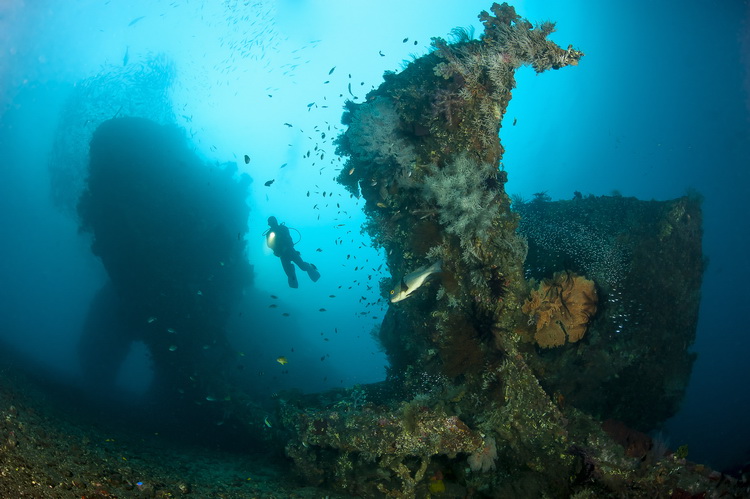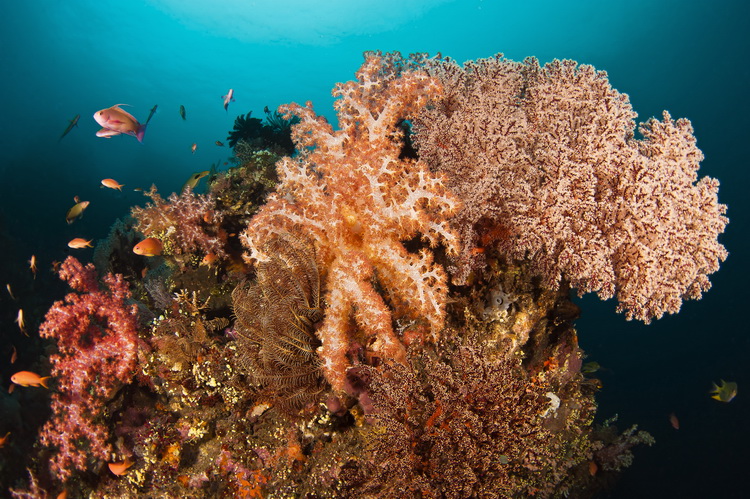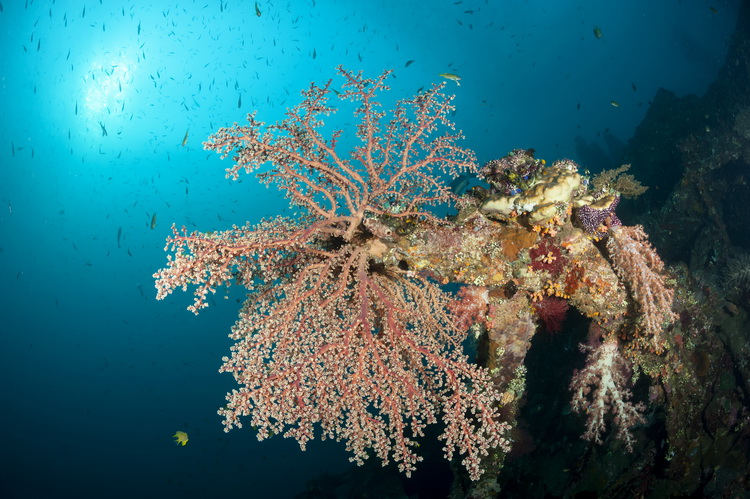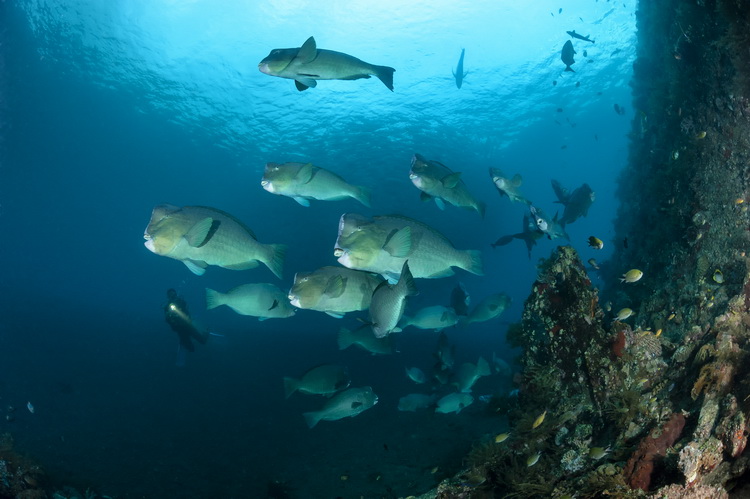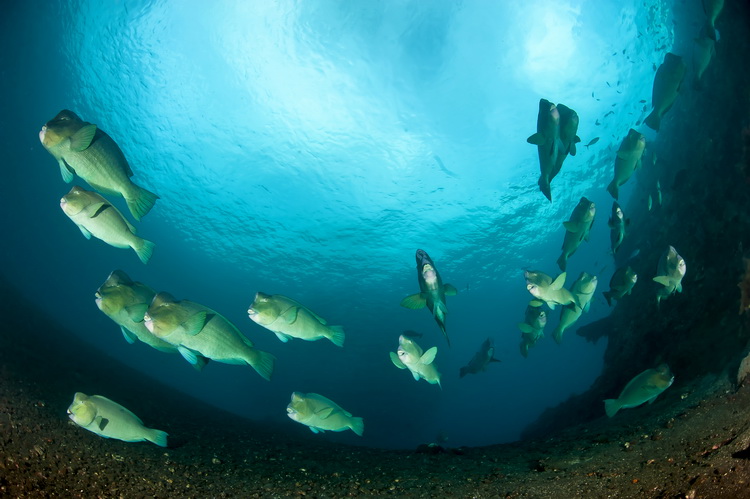Liberty Wreck Photography Guide… I like to think of the wreck of the USAT Liberty at Tulumben as a living breathing thing. It is, in many ways, a metaphor for the incredible bio-diversity of the vast Indonesian archipelago. Take a large metal structure, roll it down the beach during an earthquake and then let it marinate in the rich waters of the Indonesian Throughflow. And voila, within a few years an incredible ecosystem is created.
It is also (in my opinion…) highly representative of the vast majority of the Indonesian people themselves. Dealing with what life has dealt them and just getting on with life as best they can.
Life for the Liberty wreck is not easy, it is getting old and frail. It’s very structure is decaying and every time there is a big storm in Tulamben something falls off the wreck. Then there is the constant stream of divers… Many with terrible buoyancy, wreaking havoc among the delicate soft corals and slow-growing hard coral trees. But even the careful ones leave a trace as the oxygen in their expired bubbles accelerates the wreck’s corrosion.
Finally there are the underwater photographers (me included…). So “focused” are they on getting that special image they often leave a trail of destruction behind them. Often without even realizing what they have done!
And yet, just like the Indonesians themselves, the Liberty wreck and its many inhabitants just get on with things. With the Indonesian Throughflow as the catalyst that sustains and nourishes this amazing ecosystem.
Liberty Wreck Photography – Photogenics
Sadly, in terms of sheer photogenic capacity the USAT Liberty is simply not what it once was. The wreck used to be covered in large soft and hard corals, gorgonian sea fans and much more. But age, storms and the incredible amount of divers that do their laps around it have taken a huge toll!
I first dived the Liberty almost 20 years ago and have made regular on-going visits since then. It is a sad experience to look back at images from those dives and just how utterly photogenic it was. But life goes on and regulating the number of divers allowed on the wreck is not possible in Tulamben.
All that said, Liberty wreck photography is still a most rewarding experience. Because what created the incredible ecosystem that is the Liberty wreck still sustains it! The waters of the Indonesian Throughflow are still as rich as they always were. And so that ecosystem continues on unabated, it just does not looks as good as it used to!
I strongly believe that if the heavy diving traffic that destroyed all that beautiful marine growth were to stop. Within a couple of years the wreck would be restored to its former pristine beauty. But sadly, that just ain’t going to happen. So we just have to adjust to the what the Liberty wreck is now – not what it used to be.
And what that basically means for Liberty wreck photography is a less wide-angle and more macro…
Liberty Wreck Photography – Before Dawn
The Liberty comes to life early each day… And to make the most of that you need to be kitted up and ready to go by 06.00. Because that is the time the resident school of bumphead parrotfish gather around the stern of the wreck.
The bumpheads spend each night down in the bow area, where they rest in the shelter of the hull. But rise early and congregate around the stern as the first sun rays start to light up the wreck. It seems like they like to perform their morning ablutions en masse before heading out for the day… They disappear soon after first light – to where, nobody knows!
If you are lucky you will get 15 to 20 minutes with them. And with a bit of careful maneuvering, whilst keeping a wary eye on those formidable teeth. It is possible to edge up really close to the Bumpheads, which makes for some memorable photography.
First light is also a great time to get some quality time with the semi-resident school of Jacks. They like to hang out around the stern area, but as the wreck gets busy with divers, so do they… While interesting to watch, as they dart back and forth, it makes them quite difficult to photograph.
Whereas they are pretty chilled at first light…
Liberty Wreck Photography – After Breakfast
At that time of the morning, because of the wrecks position parallel to the north-east shore of Bali, the sun will be behind you and will help to illuminate the structures despite the low level of the overall light.
lucky enough to be diving on a rising tide, bringing in clear water from the deep, then once you have had your fill of the Jacks, it is a great time to photograph both the stern and the bow of the Liberty.
Both are large steel structures, which at first sight are difficult to recognize as part of a large ship, but if you take your time to understand the orientation of the wreck it is possible to define them against the negative space of the clear blue water and a good model, carefully positioned, will add a nice touch of scale.
The sheer prolificacy of the currents that run through Tulamben Bay means that the prominent large structures of the bow and stern are richly coated in marine growth and the two guns that were mounted on those structures are hardly recognizable as deadly armaments anymore.
Prophetically the gun on the bow now has a large flower like growth of gorgonian fan on its breech which will make you want to put that “If you’re going to San Francisco” tape you have been saving in to the cassette player of the VW Combi hippy wagon…
Liberty Wreck Photography – Early Morning
From 08.30 in the morning the car park will be filling up and the volcanic stone beach will have a lot of divers getting ready to enter the water.
This is the time to forget about the larger residents of the Liberty and its structures and concentrate on the smaller stuff that lives in the nooks and cracks of the wreck.
It is also when your dive guide transforms from super-model to critter finder and becomes worth their weight in gold.
Depending on how deep you meander on the wreck, the maximum bottom time you can probably expect is about one hour, and with the right guide this can be a very productive period.
On the other hand, if you go alone you will probably finish the dive wondering what all the fuss is about…
The bottom line in Tulamben is that scuba diving is the only industry in town and its relative prosperity revolves around visitors coming to experience the Liberty.
So jobs in the town all relate, in one way or the other, to the wreck and the dive guides are the local alpha-males.
They all know each other, but unlike places like the Lembeh Strait where critter locations are networked, in Tulamben the location of a photogenic critter is kept as tight a secret as the US nuclear codes.
That’s why you need a good guide like Made Sadia from Tulamben Wreck Divers, who was the perfect combination of super-model and critter-spotter.
The Liberty Wreck is not critter-central like Lembeh Strait or the Twilight Zone, but it has a lot to see – if you can find it in amongst all the wreckage.
The mid-section of the wreck is the most prolific area, but there is stuff all over the place and a good guide like Made will know where to find it.
You can easily do two very productive and enjoyable dives mid-morning and early afternoon by looking down in amongst the wreckage and simply ignoring the promenade of scuba-diving tourists doing their obligatory circuit of the wreck above you!
Liberty Wreck Photography – Siang…
By about 15.30 the tourists are packing up and getting back in their cars and buses and, just like the house vendor after one of those necessary, but very painful open houses, the residents of the wreck start to reclaim their home after everybody has left.
Usually the visibility is not too good at this point because all the visitors have stirred things up a bit, plus the light fades rapidly as the sun dips behind the 3000m high Mount Agung volcano that dominates Tulamben.
But it is still a good time of the day to put a wide-angle lens back on your camera and photograph the beautiful and incredibly prolific soft corals around the deeper sections of the wreck’s mid-section.
It never ceases to amaze me just how rich these corals are and very interestingly how much they evolve over time.
I have been diving and taking photographs of the Liberty for over 13 years and strikingly photogenic hard and soft corals in this area seem to come and go from year to year.
Without a doubt the heavy traffic of inexperienced and often deliberately over-weighted “resort divers” take its toll, but incredibly the wreck seems able to regenerate itself.
The only rational explanation of this regeneration phenomenon has to be the sheer fecundity of the currents that wash over the wreck as they head for the Lombok Strait and the Indian Ocean to the south.
Liberty Wreck Photography – Late Afternoon
This is a good time on the wreck as calm is returning again… It’s not always perfect as the visitors have usually stirred up the visibility and scared off most of the inhabitants, but just as the wreck seems to have worked out how to deal with the daily influx, so have the locals!
Liberty Wreck Photography – After Dark
A night dive on the Liberty is a special thing, but one that needs to be considered carefully because it’s easy to get lost and a little bit disorientated during the day, so after dark you can almost guarantee you will.
The Tulamben dive guides know the wreck better than the backs of their hands, and so would you if you were diving it every day of the week. They also know the best place to find stuff once darkness has fallen on the Liberty.
So do yourself a favor and use a guide to dive the wreck at night and experience it at its eerie best!
Liberty Wreck Photography – Random Encounters
As the old saying goes – “you should have been here last week” and you will be sure to hear that regularly in Tulamben, because the wreck acts as a beacon to the true pelagics of the Indo-Pacific.
Mola Mola’s are spotted regularly around the Liberty in the deep waters around the mid-section, particularly around August & September when they become quite common.
Whale shark’s also put in periodic appearances and on my last dive of this trip, while I was down at the bow in the early morning light trying to get that front cover shot, a 4m whale shark was entertaining a group of Japanese divers at the stern.
We emerged around the same time and, while my Japanese is limited to “thank you” and “one more beer please”, I could tell they were very excited about something and eager to share their images.
That’s the thing about the Liberty Wreck, you just never know what is around the corner and it seems to possess an almost infinite capability to surprise and enthrall you.

